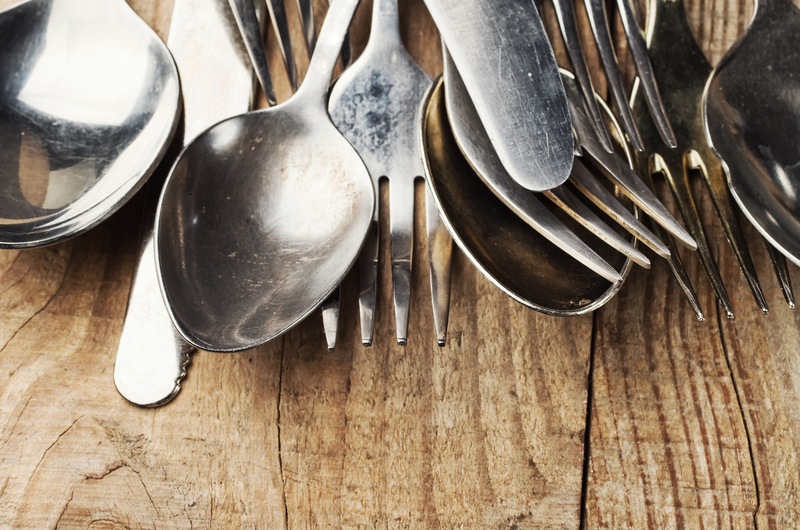Innovative Ways to Clean Your Precious Jewelry
Posted on 11/09/2025
Innovative Ways to Clean Your Precious Jewelry
Is your beloved jewelry losing its sparkle? Over time, even the finest pieces can accumulate grime, becoming dull and lackluster. While traditional cleaning methods work, there are innovative ways to clean your precious jewelry that are both safe and highly effective. This comprehensive guide delves into modern, creative, and science-backed techniques for restoring the brilliance of your treasured gems and metals at home.

Why Opt For Innovative Jewelry Cleaning Methods?
Conventional methods--like soap and water or commercial jewelry cleaners--certainly have their place. However, they often don't address unique cleaning challenges posed by intricate settings, delicate stones, or the build-up of stubborn residues. Innovative cleaning solutions:
- Save time and money by avoiding frequent professional cleanings.
- Are more eco-friendly, using non-toxic ingredients you likely already have.
- Can preserve the integrity of delicate or antique pieces.
- Remove grime from hard-to-reach places safely and effectively.
Understanding Jewelry Materials Before Cleaning
Before experimenting with any modern jewelry cleaning techniques, it's crucial to understand the materials used in your precious jewelry. Not every method is safe for every gemstone, metal, or finish.
- Gold & Platinum: Typically resilient, but can be scratched by abrasives.
- Silver: Prone to tarnishing, requires gentle anti-tarnish solutions.
- Diamonds: Tough, but settings and mounts might be delicate.
- Pearls & Opals: Highly sensitive to chemicals and excessive moisture.
- Colored Gemstones: Vary widely--consult a gemologist for unusual stones.
Always double-check manufacturer instructions or consult a professional jeweler if in doubt.
1. Ultrasonic Jewelry Cleaners
One of the most innovative techniques for cleaning jewelry at home is the use of ultrasonic cleaners. These devices use high-frequency sound waves to agitate a cleaning solution, creating microscopic bubbles that lift dirt, oils, and even ingrained debris from every crevice.
How It Works:
- Fill the ultrasonic tank with water and a few drops of mild dish soap (or a special ultrasonic cleaning solution).
- Place your jewelry in the provided basket--never let pieces touch each other.
- Turn on the device. Typical cycles last 3-10 minutes.
- Rinse and buff dry with a soft, lint-free cloth.
Note: Not suitable for pearls, emeralds, opals, or jewelry with loose settings. Always check recommendations for your specific gem or metal.
2. Natural Ultrasonic Alternatives: DIY Sonic Cleaners
Don't want to invest in an ultrasonic machine? Consider sonic toothbrushes or high-frequency electric toothbrushes as a safe, budget-friendly alternative.
Instructions:
- Apply a gentle, non-abrasive toothpaste or baking soda paste to your jewelry.
- Use the soft bristles and vibrating action of the toothbrush to dislodge dirt.
- Rinse thoroughly with lukewarm water.
- Pat dry with a soft, clean cloth.
This method is perfect for cleaning intricate mountings and inlays where grime often hides.
3. Steam Jewelry Cleaners
A modern upgrade to manual cleaning is the use of steam cleaners for jewelry. Professional jewelers have used steam for decades, but now compact, home-safe versions are available.
Benefits & How-To:
- No harsh chemicals: Only water vapor is used, making it safe for most metals and diamonds.
- Effectively loosens oils and stuck-on debris.
- Hold the jewelry in the blast zone (using tweezers for safety) for a few seconds.
- Dry with a microfiber cloth to prevent water spots.
Warning: Avoid for porous gems, glued settings, or fragile antiques. Test on less valuable pieces first.
4. The Power of Alcohol Baths
Isopropyl alcohol is a miraculous, gentle solvent for safely cleaning many types of fine jewelry. It dissolves oily residues, evaporates quickly, and won't tarnish most metals.
How to Use:
- Pour alcohol into a small bowl or a shot glass.
- Drop in rings, earrings, or chains (avoid glued-in stones).
- Let soak for a few minutes, then gently wipe with a soft brush.
- Rinse with cool water and thoroughly dry to avoid water spots.
*Don't use alcohol on pearls, opals, emeralds, or costume jewelry with adhesives.*
5. Hydrogen Peroxide & Baking Soda Paste for Deep Cleans
For deep-set grime and germ-killing power, hydrogen peroxide combined with baking soda is exceptional. The fizzing action lifts embedded dirt, while baking soda acts as a mild abrasive.
Recipe and Steps:
- Mix 2 parts baking soda with 1 part hydrogen peroxide to create a thick paste.
- Apply to jewelry with a soft brush (a baby toothbrush works well).
- Let sit for a minute (avoid prolonged soaking, especially for delicate stones).
- Gently scrub; rinse in cool water and dry.
Pro tip: This method is great for sterling silver but shouldn't be used on pearls or vintage costume jewelry.
6. Jewelry Cleaning with Effervescent Tablets
Have you heard about using denture tablets or effervescent antacid tablets to clean jewelry? Their fizzing action effectively removes grime.
How to Use:
- Dissolve a tablet in a glass of warm (not hot) water.
- Soak jewelry for 2-5 minutes.
- For extra shine, gently brush with a soft toothbrush.
- Rinse well and pat dry.
Ideal for gold, platinum, and diamond jewelry--not suited for delicately glued stones or porous gems.
7. Eco-Friendly Innovations: Plant-Based Cleaners
With sustainability in mind, plant-derived soaps and cleansers specifically designed for jewelry are making waves. These solutions clean gently, smell fresh, and do not irritate sensitive skin.
- Apply a few drops to a bowl of warm water.
- Let jewelry soak for 5-10 minutes.
- Scrub gently with a soft brush or cloth.
- Rinse and dry thoroughly.
Look for products marked as non-toxic, biodegradable, or vegan for a truly environmentally friendly touch.
8. Gemstone-Specific Polishing Cloths
Some innovations focus on convenience: pre-moistened or formula-infused cloths are now available for diamonds, silver, gold, and even pearls.
- Simply wipe the jewelry until it shines, following the grain (for metals).
- For silver, choose an anti-tarnish cloth for lasting brilliance.
These cloths are travel-friendly and perfect for touch-ups between deep cleanings.
9. Portable Jewelry Cleaning Pens
For on-the-go sparkle, jewelry cleaning pens are a must-have innovation. These pens dispense a gentle, specialized cleaning solution with a built-in brush tip.
Usage Tips:
- Twist or click to dispense solution.
- Brush onto dirty settings or stones.
- Wipe off residue with a soft cloth or tissue.
Ideal for daily wear pieces like engagement rings and stud earrings.
10. Jewelry Cleaning with Household Staples
Did you know several kitchen staples serve as excellent jewelry cleaners? Here's how to use them:
Baking Soda and Vinegar
- Sprinkle baking soda over silver; pour vinegar to initiate a fizzing effect.
- Let sit for 2-3 minutes.
- Rinse and dry; enjoy the revived shine!
Club Soda Soak
- Drop jewelry (diamonds, rubies, sapphires) into a glass of club soda.
- Let soak overnight to restore luster.
*Avoid vinegar for antique pieces, pearls, and softer stones.*
Smart Tips for Safe At-Home Jewelry Cleaning
- Always inspect for loose gems or damaged parts before cleaning.
- Use a mesh strainer for small pieces when soaking to avoid losing them.
- Dry thoroughly to prevent water spots and tarnish.
- Store jewelry in anti-tarnish bags or soft pouches after cleaning.
- Avoid exposing cleaning solutions to pearls, opals, emeralds, or turquoise.
Professional vs. Home Jewelry Cleaning
While these cutting-edge home jewelry cleaning methods can revitalize most items, some pieces require the expertise of a professional jeweler. Choose professional cleaning and inspection if:
- The jewelry is vintage, heirloom, or extremely valuable.
- You notice loose prongs, missing gems, or intricate damage.
- The piece contains multiple delicate stones or is an antique.
- It's been six months or longer since the last professional check-up.
A hybrid approach--professional deep cleaning annually and innovative at-home techniques monthly--is the best way to keep jewelry sparkling and secure.

FAQs - Your Jewelry Cleaning Questions Answered
Q: How often should I clean my precious jewelry at home?
A: Ideally, clean every two to four weeks for frequently worn pieces, and at least every six months for seldom-used items.
Q: Are innovative jewelry cleaning solutions safe for all gemstones?
A: Not all! Always research your stones--pearls, opals, emeralds, and turquoise need special care. For most diamonds, gold, and platinum, these methods are safe, but double-check individual recommendations.
Q: Can I use toothpaste to clean gold and silver jewelry?
A: Toothpaste is slightly abrasive--safe for hard stones but might scratch gold, silver, or soft gems. Use a non-abrasive toothpaste and a very soft brush.
Conclusion: Embrace Innovation, Preserve the Sparkle
Modern jewelry cleaning has come a long way from old-fashioned soapy water! By embracing innovative ways to clean your precious jewelry, you ensure safe, thorough care for your treasured items. Whether you try ultrasonic technology, clever household hacks, eco-friendly solutions, or portable cleaning innovations, your jewelry will reward you with lasting shine and brilliance. Take the time to learn the right method for your gems and metals, and enjoy the confidence that comes with a dazzling accessory!
Remember: A little regular TLC and innovation go a long way in preserving the value and beauty of your cherished jewelry.





